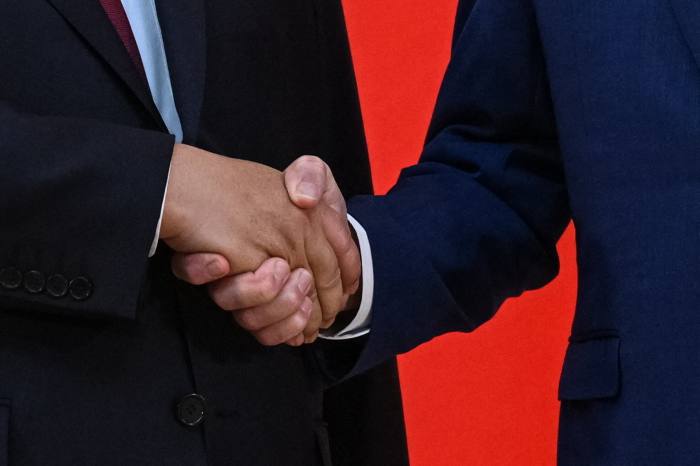In late 2022, Germany’s domestic intelligence chief, Thomas Haldenwang, put it well: “Russia is the storm,” he told German parliamentarians. “China is climate change.”
Last year was also the first time the US administration acted as if it truly believed that distinction. Though most of president Joe Biden’s attention was directed at Russia following its invasion of Ukraine in February, his most consequential steps in 2022 targeted China. The uncertainty is no longer about whether US-China decoupling will happen but how far it will go. Much of the answer will become clear in 2023.
Vladimir Putin’s “special military operation” offered Biden a perfect case study in the dangers of weaponised interdependence. Having shuttered almost all of its nuclear power sector, Germany’s reliance on Russian gas and oil meant there was no constraint on Putin’s war aims. Germany’s so-called Zeitenwende shortly after Russia’s invasion brought to an end its decades-long bet that deep commercial ties would moderate Russia’s hostilities towards its neighbours. Biden is trying to apply that lesson to the west’s far greater supply chain dependence on China.
This raises two pressing questions. What does Biden mean by decoupling? And will the US be able to bring its allies and partners along?
On the first, the US administration is still feeling its way. Biden inherited a series of ad hoc punitive trade measures that Donald Trump’s presidency imposed on China — tariffs on steel and aluminium exports, as well as various export controls on Chinese telecoms companies, notably Huawei and ZTE. None of these have been reversed. Biden has even retained Trump’s metal tariffs on most of the US’s non-Chinese trading partners. Last month, Washington rebuked the World Trade Organization’s ruling that the US had broken world trading rules in having done so. This implies the US has no intention of returning to the rules-based WTO global trading order that it designed.
In October, Biden took the world a step closer to full blown economic bipolarity. The US commerce department issued orders to shut off China’s access to advanced semiconductors. This action was taken on the basis that Chinese leader Xi Jinping’s drive for “civil-military fusion” meant China’s economic development could no longer be disentangled from its accelerating military reach. Jake Sullivan, Biden’s national security director, reassured nervous US and allied chipmakers and suppliers that this would be a “small yard” with a “high fence” — the scope of affected commercial activity would be limited. Yet he added Washington was considering similar restrictions on US-China biotechnology and clean energy ties. The effects on swaths of economic activity — from artificial intelligence and quantum computing, to critical minerals, batteries and commercial drones — are hard to quantify.
The reality is that Biden is improvising as he goes along. His administration includes classic free traders, who still believe in positive sum globalisation, and others who see US-China rivalry as a zero sum contest in which only one power can prevail. The White House’s national security strategy does not clarify things much. It gives top billing to great power competition between the US and China, while stressing the need for co-operation to confront common threats, like global warming and the next pandemic. The suspicion is that, on China, Biden’s competition imperative will take precedence over his co-operative one.
If that is Biden’s path, he will need to bring key US allies and commercial partners with him. Official talk is of “friendshoring”. This would involve relocating China-centric supply chains to like-minded countries such as Vietnam, India and Mexico. Some of that was already happening because of China’s now abandoned zero-Covid policy. For example, Apple plans to produce about a quarter of its iPhones in south India. But the extent of global reliance on China as a supplier of intermediate goods across most areas of modern production means the US’s implicit goal is little short of bifurcation.

That would slow global growth and sharpen the dilemma for US friends that are highly interdependent with China. Examples include the UAE and Singapore. Neither wants to be forced to choose between the US and China and such a choice could boomerang on the US. Friendshoring could “shut off avenues for regional growth and co-operation”, says Singapore’s prime minister, Lee Hsien Loong, and may prompt “the very conflicts that we all hope to avoid”.
China and the US continue to build military capacity in the Indopacific. Last month, a senior US defence official said 2023 would be “the most transformative year in US force posture in the region for a generation”. This came days after Chinese planes intruded on Taiwanese airspace — the latest egregious incursion that followed the passage of the US budget that allocated $10bn in Taiwan military assistance.
Whatever its pace over the present year, the US-China relationship is heading in an ominous direction. Businesses, countries, regions and the world are only just starting to grapple with the potential consequences.






